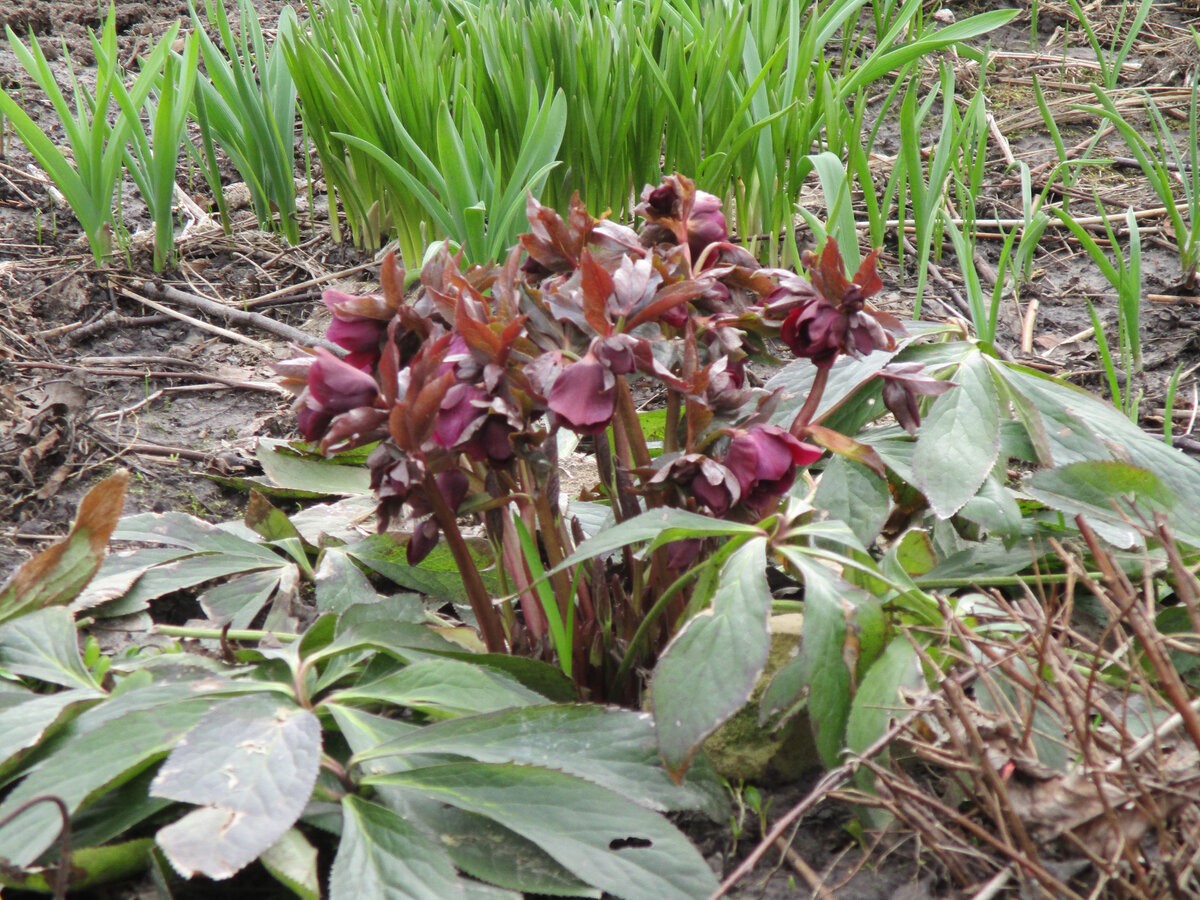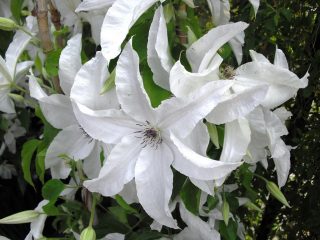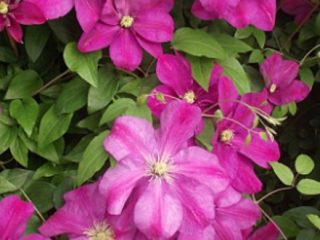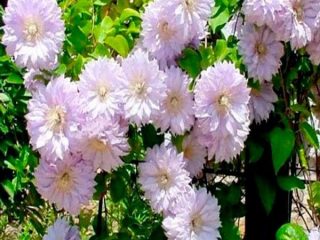Content
The photo and description of Tricyrtis allows you to appreciate the beauty of this flower. Decorates the garden with interesting petals, often light in color with purple specks. The plant is shade-tolerant, well suited for planting under large trees and shrubs. The basic rules for planting and caring for this flower are described in detail in the presented material.
Description of Tricyrtis with photo
Tricyrtis is a perennial plant with a short rhizome. The shoots produce quite a lot of leaves, often have a cylindrical shape, and are erect. The leaf blades are arranged alternately; they are sessile or stem-enclosing. The shape depends on the variety - it can be oblong, ovoid. The color is uniform green, sometimes with darker spots. Some varieties of Tricyrtis are densely covered with pubescence (both on the leaves and on the shoots). They are more adapted to adverse weather conditions.
The flowers grow solitarily and can also be combined into bunches or semi-umbrellas.The shape is funnel-shaped, there are only six petals, they are elongated and look elegant. Various colors:
- yellow;
- white;
- cream;
- bluish.
Depending on the variety, Tricyrtis flowers can be either single-colored or with numerous specks, mostly purple and dark lilac. The perianth is surrounded by outer leaves, on which small sacs containing nectar grow. They attract bees and other pollinators.
Flowering of Tricyrtis perennial is observed mainly in June. There are varieties with earlier (May) and later (July) dates. If you select several different representatives, the flowerbed will look beautiful throughout the first half of summer. By the end of the season, the flowers fade, and in their place fruits appear in the form of an elongated box. In autumn, brown or black seeds ripen in them.
Hybrids produce infertile offspring, so it is better to purchase seeds in a specialized store.

Flowers with specks are especially beautiful
Types and varieties
There are several varieties of Tricyrtis, almost all of them come from China and Japan. They differ from each other in the shape of the leaves, height and color of the flowers. The most beautiful representatives are described below.
Taiwanese
The Tricyrtis plant of this variety is also called Formosan (Tricyrtis formosana). This is a tall shrub that reaches a height of 80 cm. Numerous fibers are noticeable on the shoots of the plant. The leaves are oval, glossy, green, with dark red spots. The flowers are small, lilac-pink, and also pink-white. Numerous red-brown specks are visible on the surface.

Flowers with graceful petals will decorate any flower bed
Yellow
The yellow variety (Tricyrtis flava) is of medium height - can reach from 25 to 50 cm. Its distinctive feature is the hairs on the surface of the stem. The flowers grow at the tops, as in other varieties. Their color is uniform yellow, each inflorescence consists of six identical petals. The variety comes from Japan, but is not yet very widespread in Russia.
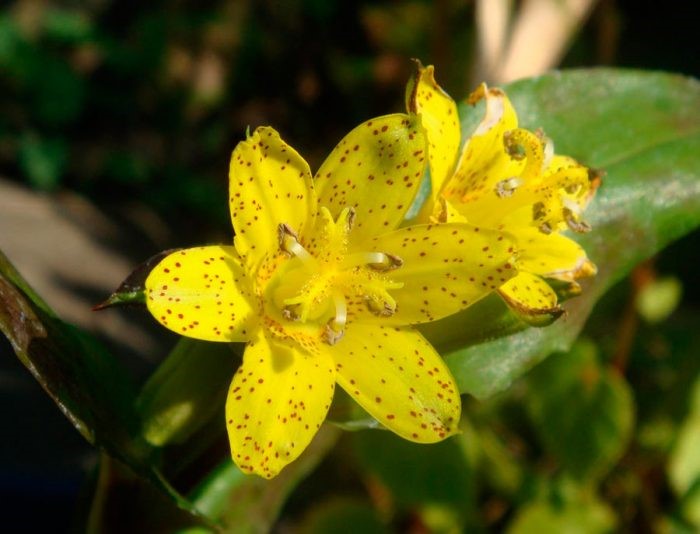
The flowers are yellow and sometimes spotted
hairy
The hairy variety of Tricyrtis (Tricyrtis pilosa) comes from the Himalayas, grows even at an altitude of 1500-2000 m, and therefore adapts well to adverse weather conditions. The peduncles are quite tall, reaching 60-70 cm. The leaves are lanceolate, narrow and elongated, with pubescence below. The flowers are whitish, with purple spots visible on the surface.

The petals of this variety of Tricyrtis are narrower than those of others.
Long-legged
The long-legged variety (Tricyrtis macropoda) produces long peduncles up to 40-70 cm. The foliage is oval, rather large, covered with soft pubescence. The plates reach 13 cm in length and 5-6 cm in width. The flowers are light pink.

White-pink flowers covered with red specks
Tricyrtis latifolia
The broad-leaved variety (Tricyrtis latifolia) produces stems up to 60 cm high. The foliage is wide, ovoid in shape. The color is green, with spots of darker shades visible on the surface. The flowers are greenish-white, with a yellowish tint. They grow singly at the tops of stems, and can also be combined into bunches in leaf axils or into semi-umbrellas.

The broadleaf variety begins to bloom in mid-summer
Tricyrtis short-haired (Hirta)
The photo and description of Tricyrtis hirta shows that its flowers have graceful petals and beautiful colors.The bushes are quite tall - from 40 to 80 cm; they grow naturally in the subtropical region of Japan. The stems are cylindrical in shape, with dense pubescence of short hairs.
The leaf blades of Tricyrtis are elongated, up to 15 cm, and up to 5 cm wide. Mostly elliptical or broadly lanceolate. They also have a pubescence of numerous fleecy short hairs, which is why the name of the variety is associated.
The flowers grow solitary, but can be grouped together in several pieces. They appear on the apical parts of the shoots and are also found in the axils. The color is white, with numerous purple and lilac spots, as can be seen in the photo of the short-haired tricirtis.

Graceful flowers with numerous purple spots
Based on this variety, several varieties of Tricyrtis have been bred, which differ in the color of the inflorescences:
- Masamuna (Tricyrtis Masam) is a bush without pubescence.
- Dark Beauty - with pale pink flowers decorated with purple specks.
- Raspberry Muss - tricirtis with brown-purple flowers, without specks.
- Blue Heaven produces leathery leaves. The bell-shaped flowers have beautiful light orange stamens and red pistils. Moreover, the lower part of the petals is blue, and the upper part is yellow. Towards the end of flowering, the color changes to purple and the tips become blue.
- Purple Beauty is a tricyrtis with classic white flowers decorated with purple specks.
Planting and caring for tricirtis in open ground
Tritsirtis is usually planted with seeds, and it is best to sow before winter, i.e. at the end of October - the first half of November. If this is not possible, the seed material must be stratified, i.e. Place on the bottom shelf of the refrigerator for 1.5-2 months.The rules for planting and caring for flowers are described in more detail in the following sections.
Landing rules
To get beautiful flowers, you need to select a site and prepare it. The place should be shady, next to trees or large shrubs - abundant sunlight prevents Tricyrtis from forming buds. If possible, the flowerbed should be protected from draft winds, for example, located next to a fence.
The plant needs fertile and loose soil with a slightly acidic reaction. It is advisable to prepare the soil in advance - dig it up and apply fertilizer, for example, half a bucket of compost for each square meter. If the soil is clayey, you should add 2-3 kg of sawdust or sand to the same area.
The process of sowing seeds looks like this:
- Level the area.
- Mark several rows at a distance of 7-10 cm.
- The seeds are buried only 3-5 mm and lightly sprinkled with soil.
- Carefully water and cover with mulch or agrofibre for the winter.
- In early spring, the shelter is removed.
If everything is done correctly, Tricyrtis will begin to produce flowers 2-3 years after planting. If you need to speed up this process, it is better to choose other methods of propagation, for example, by dividing a bush or rhizome.
Watering and fertilizing
The tricirtis flower is drought-resistant, but at the same time needs frequent watering. It is better to plan them weekly, and in hot weather - twice as often. Water is poured strictly at the root, without touching the leaves and flowers. It is preliminarily settled for 12 hours.
Tricyrtis does not need feeding. Only occasionally can it be given complex mineral fertilizer, especially during the flowering period (only 2-3 times per season). It is allowed to alternate with organic matter, for example, mullein infusion 1:10.
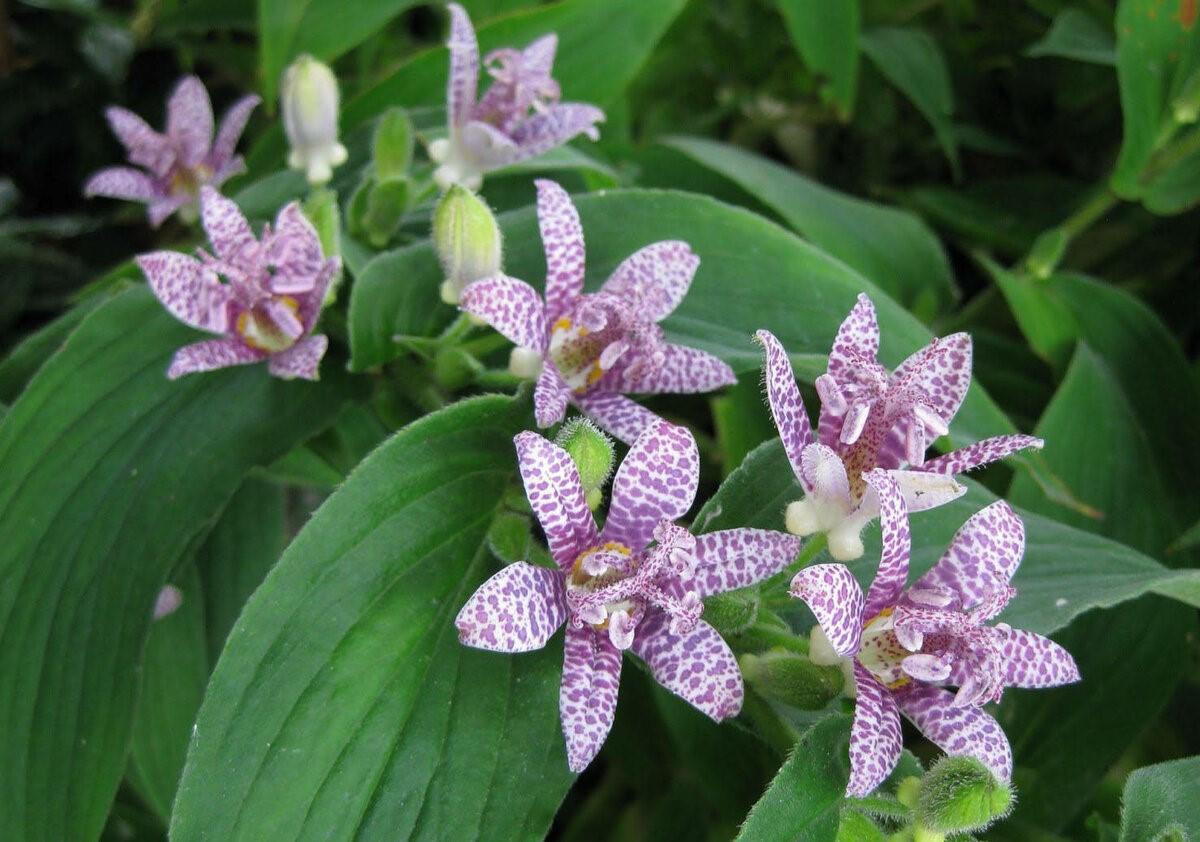
For lush flowering, it is advisable to feed tricirtis 2-3 times per season.
Trimming
Tritsirtis is pruned already in the first season. It is advisable to remove all shoots with buds so that the bush gains strength. It is better to refuse flowering so that the plant takes root in a new place. In subsequent seasons, it is enough to remove faded flower stalks,
Wintering
Even winter-hardy varieties of Tricyrtis flower need shelter. In late autumn they are mulched with peat, fallen leaves, or agrofibre can also be used. In the south, it is also advisable to create a small shelter in case the winter has little snow.
Reproduction methods
Tricyrtis flower can be propagated in three ways:
- seeds;
- dividing the bush;
- dividing the rhizome.
In the first case, the seeds are sown directly into the ground at the end of autumn (before winter) or in the spring, closer to mid-May. Mature bushes can be divided into several parts in the spring. They are dug up, shaken off the ground and planted in a new place.
Since the tricirtis flower has a developed rhizome, it can also be used for propagation. To do this, at the end of spring, the shoot that grows above the soil is separated. It is cut off along with part of the root and transferred to a new place, after which it is watered and fed.
Diseases and pests
Tricyrtis is resistant to almost all diseases. The threat of infection is created only in case of abundant watering. It is important to remember that the flower grows in the shade, where the soil dries out much more slowly. Therefore, it is necessary to observe the watering norm, and if signs of disease appear, treat with fungicides:
- "Bordeaux mixture";
- "Fundazol";
- "Tattu."
Of the pests, slugs and snails are especially dangerous. You can fight them with special drugs, for example, “Thunderstorm” or “Ulitsid”.It is also recommended to scatter nut or eggshells, ground red pepper, and mustard powder around the flowerbed.
Application in landscape design
Tricyrtis look beautiful in single plantings. Due to their shade tolerance, the flowers are used to decorate tree trunks and placed next to tall shrubs. The main uses in garden design are:
- For decorating unattractive places.
- Planting in a shady part of the garden.
- Composition with hosts.
- Landing near the house.
Conclusion
Photos and descriptions of Tricyrtis show that it is a beautiful plant with graceful flowers. It is unpretentious and grows well in the shade, which makes it different from many other species. For care, it is important to pay attention to regular watering, as well as winter shelter.
Reviews about Tricyrtis




